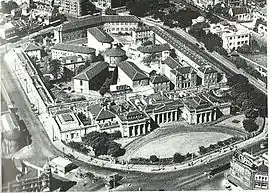Darlinghurst Gaol
The Darlinghurst Gaol is a former Australian prison located in Darlinghurst, New South Wales. The site is bordered by Victoria, Burton and Forbes streets, with entrances on Forbes and Burton Streets. The heritage-listed building, predominately designed by New South Wales Colonial Architect Mortimer Lewis, was closed in 1914 and has subsequently been repurposed to house the National Art School.[1]
 An aerial view of Darlinghurst Gaol, with the courthouse in the foreground, 1930 | |
 Former Darlinghurst Gaol Location in Greater Sydney | |
| Location | Darlinghurst, New South Wales |
|---|---|
| Coordinates | 33°52′47″S 151°13′07″E |
| Status | Closed; repurposed as an art school |
| Opened | 7 June 1841 |
| Closed | 1914 |
History
_National_Art_School_gates.JPG.webp)
_National_Art_School_(b).JPG.webp)
Construction commenced with pegging out by Francis Greenway in 1821.[2] The Darlinghurst Gaol wall began in 1822 and finished in 1824 using convict labour, but due to a lack of funds, the site sat empty for 12 years. Construction of the rest of the complex did not begin until 1836, with completion of some of the cell blocks in 1840. The gaol was ready for occupation a year later, with the first prisoners occupying the gaol on 7 June 1841.
The gaol was finally completed in 1885. The main material used for construction of the gaol is Sydney sandstone, cut into large blocks by convicts. Convict markings on the blocks are visible along the upper half of the wall on Darlinghurst Road. A tall circular chapel stands in the middle of the site, around which are sited the six rectangular cellblocks in a radial fashion.
Australian poet Henry Lawson spent time incarcerated here during some of the turbulent years of his life and described the gaol as Starvinghurst Gaol due to meagre rations given to the inmates. The site is now open to the public as The National Art School. The last hanging at the gaol was in 1907.[3]
Hangings were open to public viewing throughout several decades. People would gather at the front gate of the gaol in Forbes Street, and the condemned would be brought out on a platform built above the gaol gate. The public executioner Alexander Green lived for a time in a hut outside the eastern wall of the gaol, would then leave his house to the jeers and catcalls of the gathering crowd, enter the prison and do his job. Seventy-six people were hanged at Darlinghurst Gaol, but most of them met their demise on the scaffold inside the gaol in a corner of E-wing. Among those who met their demise at the end of a rope were bushranger Andrew George Scott, better known as Captain Moonlite, in 1880, and the last woman to be hanged in NSW, Louisa Collins, in 1889.[4]
Modern-day use
The site was transferred in 1921 to the New South Wales Department of Education, who adapted the building for use as the East Sydney Technical College. The National Art School was established in 1922 and is now the sole occupant of the site.
The Darlinghurst Road side of the Gaol, (commonly known as "the wall") was for many years a popular place for male prostitutes to offer their services.
Notable prisoners

- Thomas and John Clarke – bushrangers from the upper Shoalhaven in south-east New South Wales, hanged on 25 June 1867.
- Louisa Collins[4] – the last woman to hang in New South Wales.
- Albert Thomas Dryer – medical doctor and founder of the Irish National Association of Australasia.
- John Dunn – Australian bushranger, member of Ben Hall's gang, hanged in the gaol on 19 March 1866.
- Frank Gardiner – Australian bushranger and mastermind of the Forbes gold escort robbery at Eugowra on 15 June 1862 (sentenced to 32 years, but pardoned early).
- Jimmy Governor – upon whom Thomas Keneally based his novel, The Chant of Jimmie Blacksmith.
- Henry Lawson – Australian writer and poet.
- Henry James O'Farrell – Irish Australian attempted political assassin.
- Andrew George Scott – known as Captain Moonlite, Irish-Australian bushranger.
- John Vane[5] – a bushranger who was member of Ben Hall's gang.
- Sir George Dibbs – Colonial politician gaoled for a year in 1880 for slander relating to a widely reported adultery case. He was perceived by the electorate as the underdog, and his political popularity was restored.
References
- "Former East Sydney Technical College and Darlinghurst Gaol Including Buildings A". New South Wales State Heritage Register. Office of Environment and Heritage. Retrieved 22 November 2017.
- "Darlinghurst Gaol (former) (Place ID 2198)". Australian Heritage Database. Department of the Environment. 21 March 1978. Retrieved 22 November 2017.
- NSW Police Website Archived 29 August 2007 at the Wayback Machine
- R. v. Collins, Moreton Bay Courier (NSWSupC 8 December 1888).
- "John Vane, Bushranger". 20 March 1909. p. 13. Retrieved 31 October 2014.
Further reading
- Beck, Deborah (2005). Hope in Hell: a history of Darlinghurst Gaol and the National Art School. Allen and Unwin.
- Kerr, James Semple (1988). Out of Sight, Out of Mind. S.H. Ervin Gallery. Sydney: National Trust of Australia (NSW).
External links
- National Art School – The school occupying the site today
- reference and article (CC-by-sa) in the Dictionary of Sydney
- State Library of New South Wales – Discover Collections – Halls of Justice
- "Darlinghurst Gaol". Dictionary of Sydney. 2008. Retrieved 26 September 2015. [CC-By-SA]